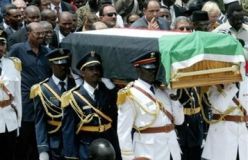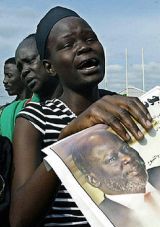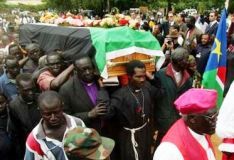Sudan’s Garang laid to rest as grieving crowds mourn him
JUBA, Sudan, Aug 6 (AFP) — Huge crowds of grieving Sudanese bade a final farewell to late ex-rebel chief John Garang who led southern Sudan through two decades of war before becoming vice president in a landmark peace deal.

|
|
President of Sudan Omar al-Bashir, South African President Thabo Mbeki, second and third from left, and other dignitaries walk behind the coffin of John Garang, First Vice President of Sudan as it is carried by Sudanese soldiers upon its arrival in Juba, Sudan Saturday, Aug. 6, 2005. (AP). |
As tens of thousands of weeping, wailing black-clad mourners thronged the south’s main city for his funeral, appeals for unity resounded amid fears for the collapse of the January deal that ended Sudan’s 21 years of north-south conflict.
With gestures laden with symbols of reconciliation between the country’s Muslim north and mainly Christian and animist south, Garang was eulogized as a man of strength and peace in an open-air service at Juba’s All Saint’s Cathedral.
Garang’s longtime nemesis, Sudanese President Omar el-Beshir, his widow, and successor as head of the Sudan People’s Liberation Movement (SPLM) urged respect for the peace accord to honor of the guerrilla leader-turned statesman.
Before the massive crowd sweltering under a blazing sun outside the church, Beshir took the hand of new SPLM supremo Salva Kiir in a sign of solidarity and vowed that Khartoum would not back away from the pact.

|
|
A Sudanese woman wails as the casket with the remains of John Garang is carried by a Sudanese Army detachment at the airport in Juba, southern Sudan for the burial. Garang died in a helicopter crash. (AFP). |
“We will be strong and together,” Beshir said to applause from the masses. “We say to our brother Salva Kiir that we will remain hand-in-hand to apply the peace agreement to the letter.”
Kiir, who will soon assume the vice presidency that Garang, a 60-year-old US-educated agronomist, had been sworn into just three weeks before his death, echoed those sentiments.
“I say it loud and clear that the SPLM is vehicle with no reverse gear,” Kiir said. “I reiterate my commitment to the implementation of all the clauses of the (peace deal).”
Garang’s widow, Rebecca, said her husband’s legacy would be best honored by peace and told the crowd she need not be consoled if the settlement, known as the Comprehensive Peace Agreement (CPA) was respected.
“I will not miss my husband as long the people of Sudan are the watchdogs of the CPA,” she said. “If you play around, I will start to cry and mourn my husband.”

|
|
Pallbearers carry the coffin of late SPLM leader and first vice president of Sudan John Garang to All Saints cathedral for a funeral service in Juba, August 6, 2005 (.Reuters). |
“Leaders come and go, but what they leave behind is very important,” she said. “I want the CPA to be implemented as it is, no changes.”
As the service continued, dozens of distraught women ululating outside the cathedral fainted in the blistering heat that held until a heavy downpour hit Juba shortly after Garang was interred in a hastily built hilltop mausoleum nearby.
Female choir members burst into tears as they sang hymns while the area around the church seethed with grieving residents of southern Sudan which under the peace deal will enjoy six years of autonomy before holding a referendum on secession.
“This is the worst tragedy in southern Sudan, we are saddened by the death of our leader, it will never be the same again in this part of the world,” said mourner Denis Lado.
“Garang is a hero, he defied death in war, but only passed away in peace,” said mourner Peter Juok. “There is no reward God could gave him except dying in peacetime.”
Organizers had taken pains to ensure the funeral conveyed a message of unity, particularly amid deep suspicion in the south over the cause of the July 30 helicopter crash in which Garang was killed.
Despite their efforts, distrust between northerners and southerners was palpable as thousands of heavily armed Sudanese soldiers patrolled the streets and a UN helicopter buzzed overhead due to security concerns.
Much of Juba’s minority Arab merchant community fled the town following clashes that saw at least 15 people killed and many Muslim-owned shops burned down and SPLM partisans were open in their resentment of northern Sudanese.
“The northerners hate us, we hate them, so we demand our own country,” said Jacob Malwak, one of the many in the town to voice such feelings.
“We are starving in the south, our children have never gone to school,” said 65-year-old Myriam Nyaombo. “Tell me who on earth could take the life of Garang who was our only hope after years of suffering?”
Garang was killed when an official helicopter on which he was returning to southern Sudan from Uganda crashed in what SPLM, Sudanese government and Ugandan officials have repeatedly said was an accident due to poor weather.
But on Friday, Ugandan President Yoweri Museveni, who provided Garang with the helicopter, said it might not have been an accident, becoming the first official to publicly suggest the possibility of foul play.
Despite Beshir’s assurance that the results of an international probe into the crash would be made public, suspicion ran deep among the mourners as did pessimism about a lasting peace.
“We want to know the real reasons behind our president’s death, otherwise suspicions might affect the whole reconciliation process,” said 20-year-old David Sisitu, who was not even born when Garang launched his rebellion in 1983.
“John was a great human being,” said mourner Myriam Nyuol. “Whether you like or not, unless everything about his death is transparent, the peace process will surely be wrecked at some point.”
